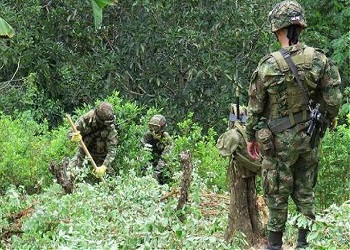Colombia’s defense minister divulged new coca eradication figures ahead of a meeting between Colombian President Juan Manuel Santos and his US counterpart Donald Trump, a sign of commitment to US policy preferences that may come at the expense of harming trust between Colombia’s government and important segments of its own population.
Defense Minister Luis Carlos Villegas said Colombia has eradicated 15,000 hectares of coca cultivation so far this year, reported El Tiempo. This figure is close to the total amount eradicated in 2016, which was around 17,600 hectares.
Since abandoning aerial fumigation in 2015, Colombia has relied solely on manual eradication of coca crops. Security forces are thus deployed to manually apply herbicides or uproot the plants one by one.
In the past, Colombia has eradicated much greater quantities of coca using a combination of manual and aerial methods. Eradication peaked in 2008 with nearly 230,000 hectares destroyed. (See InSight Crime’s graphic below)

But the fact that Colombian authorities have eradicated nearly as much coca in less than five months this year as in all of 2016 serves as a sign of the government’s intent to place a greater emphasis on eradication after a significant drop in the practice in recent years.
SEE ALSO: Coverage of Coca
This shift was made visible earlier this year, when authorities announced that they would seek to eradicate 100,000 hectares of coca crops — half through forced eradication and the other half through crop substitution programs outlined in last year’s peace accord with the Revolutionary Armed Forces of Colombia (Fuerzas Armadas Revolucionarias de Colombia – FARC).
The announcement of the new eradication figures comes as President Juan Manuel Santos is set to meet President Donald Trump in Washington, DC on May 18. According to a White House statement, the two heads of state will discuss the implementation of the peace agreement and anti-drug strategies, among other issues.
With regard to the upcoming meeting, Villegas praised the fact that the US Congress recently approved a $450 million aid package known as “Peace Colombia,” which is aimed at supporting the country’s peace agreement with the FARC. This contrasts with Trump’s proposal to slash US foreign aid across Latin America and the globe.
InSight Crime Analysis
Amid indications that Colombia is cultivating more coca and producing more cocaine than ever, the country has been under enormous international pressure to tackle the problem, especially from its key international ally, the United States.
Shortly before Trump’s January inauguration as president, then-Vice President Joe Biden reportedly warned Colombian President Santos to place continued emphasis on anti-drug operations so as not to give the incoming Trump administration an “excuse” to cut aid to the South American nation. More recently, key congressional figures like Sen. Marco Rubio have also urged Colombia to step up anti-narcotics efforts.
“As a member of the Senate committee that appropriates foreign assistance, I believe the United States should continue to support Colombia’s efforts to combat terrorism and narcotics, and secure and stabilize the country,” Rubio wrote in a Miami Herald op-ed. “In particular, we should encourage Colombian counternarcotics officials to resume aerial eradication operations to combat coca production and stem the tide of cocaine trafficking.”
Given this context, Villegas’ announcement appears to be a signal of Colombia’s commitment to eradication ahead of the presidential summit.
SEE ALSO: Colombia News and Profiles
But even if this signal is meant to help secure US funding, it could come at a cost. As InSight Crime previously explained, the priority placed by Colombia’s government on reaching eradication goals has put enormous pressure on security forces to destroy as much coca as possible. Coupled with the lack of implementation of crop substitution programs outlined in the peace agreement, this forceful eradication campaign is fueling tensions and leading to outbreaks of violence between coca farmers and the state. Reports indicate that even farmers who have signed up and joined the substitution programs have witnessed their fields forcibly destroyed, according to Verdad Abierta.
It is unlikely that even the most intense eradication efforts will be enough to stop coca cultivation. The areas where coca is grown are simply too vast, too remote, and the coca crop — which can yield three harvests a year — simply remains the most economically viable option for a large number of poor Colombian farmers. In fact, the Colombian government is unlikely to reach its goal of eradicating 100,000 hectares of coca this year. Maintaining the current rate of eradication, the best Colombia can hope for is the destruction of 40,000 hectares by year’s end.
SEE ALSO: Coverage of Drug Policy
Support from the United States — both political and financial — will be important for the implementation of the peace agreement with the FARC. Therefore, it is understandable that the Colombian government wants to show progress on measures that US officials are watching closely. However, Colombian officials should be wary of trumpeting the new eradication figures too loudly, lest this contribute to the erosion of trust with coca farmers who will play a key role in any strategy aimed at reducing coca cultivation.

